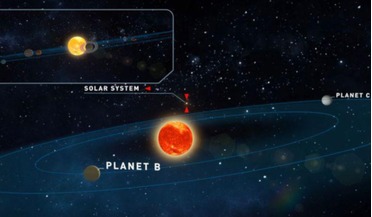 19 June 2019
Two new Earth-like planets found around nearby star
19 June 2019
Two new Earth-like planets found around nearby star
.... It has long been thought that many undiscovered dwarf stars exist within 20 light-years of Earth but their...of the Carmenes project. However, like most red and brown dwarfs Teegarden’s star emits most of its energy in the infrared spectrum giving it...
 September 2017
Science searches for cosmic company
September 2017
Science searches for cosmic company
...(LNSD) array designed to be highly effective for simultaneous surveys undertaken for SETI projects at centimetre wavelengths. Red dwarfs – stars that are both smaller and dimmer than the Sun – were traditionally of little interest to SETI researchers...
 05 June 2020
Exciting exoplanet find around sun-like star
05 June 2020
Exciting exoplanet find around sun-like star
... present on their surface – the essential ingredient for life on Earth. Again though, these planets orbit red dwarf stars. Red dwarfs do have the advantage of having extremely long lifetimes, meaning that life trying to get a foothold on an exoplanet...
 March 2017
Twinkle - a mission to unravel the story of planets in our galaxy
March 2017
Twinkle - a mission to unravel the story of planets in our galaxy
... highly eccentric. Artist’s impression of the Twinkle spacecraft. The discovery of planets around every type of star opens up new possibilities for habitability around M-dwarfs, stars cooler than our Sun that are by far the most common type...
 03 February 2020
Researchers discover "invisible" stars too dim to be seen
03 February 2020
Researchers discover "invisible" stars too dim to be seen
... University of Poland, to work out what was going on. It turns out the star, a K5-type giant or a super-giant, wasn’t behaving oddly at all. Instead two red dwarf stars at 57 percent and 36 percent of the mass of the Sun were found...
 02 August 2019
Newly found exoplanet may be suitable for life
02 August 2019
Newly found exoplanet may be suitable for life
... discoveries just announced is GJ 357 d; a super-Earth located about 31 light-years away orbiting a diminutive M-type dwarf star that has been described as relatively inactive. So far nearly 200 exoplanets have been discovered orbiting similar ...